Step-by-Step Refine for Successful Lead Violation Remediation
Resolving lead infractions requires a thorough and organized approach to make sure both safety and governing compliance. The trip begins with the specific discovery and evaluation of contamination sources, making use of cutting-edge diagnostic tools. Following this, adherence to federal and state policies is vital to formulating a reliable remediation plan. Such a strategy has to detail the details approaches and timelines for action. The actual remediation calls for experienced workers to implement these strategies while purely adhering to safety and security methods. What takes place after the removal is finished? The solution hinges on comprehending the vital post-remediation techniques that guarantee long-lasting safety and area well-being.

Discovery and Assessment
Detection and evaluation are important steps in the removal of lead infractions. To guarantee an effective remediation process, it is crucial to perform an extensive evaluation of the setting where possible lead direct exposure exists.
This consists of reviewing the degree and intensity of contamination, as well as identifying populations at danger, specifically kids and pregnant ladies. The gathered information must be diligently recorded to sustain the advancement of an effective remediation method.
Moreover, it is necessary to prioritize locations with the highest degree of contamination and those that present the best health and wellness dangers. Effective communication with stakeholders, consisting of homeowner, residents, and public health authorities, is critical for guaranteeing that all parties are educated concerning the findings and the succeeding actions needed for removal. This initial detection and analysis stage prepares for an effective lead infraction removal process.

Legal and Regulatory Compliance
Browsing the landscape of lawful and regulative conformity is a pivotal element of effective lead violation remediation. Compliance makes certain not only the security of damaged populaces but additionally the trustworthiness and lawful standing of the company liable for removal.
State and regional regulations can vary, frequently enforcing extra obligations or even more strict requirements. An extensive understanding of all appropriate legal structures is important. This includes careful documentation of all removal activities to show compliance. Failing to stick to these guidelines can lead to serious fines, consisting of significant fines, lawsuit, and reputational damage.
Involving legal experts concentrated on environmental law can facilitate navigating these complexities. Normal training and qualification for all workers associated with the remediation procedure are also necessary to guarantee adherence to safety and regulatory requirements. By focusing on lawful and regulative compliance, organizations can successfully alleviate risks and accomplish a successful remediation outcome.
Planning the Removal
Successfully planning the remediation of lead violations begins with a comprehensive analysis of the infected site. This data-driven approach guarantees that removal efforts are properly targeted and efficient.
Once the contamination is mapped, a threat assessment need to be carried out to evaluate potential health dangers to humans and the setting. Lead Violation Removal in NYC. This evaluation must other consider elements such as direct exposure pathways, population susceptability, and environmental impacts. The insights collected will develop the basis for picking a proper removal method
Ultimately, establishing clear, possible objectives for the removal job is crucial. These objectives need to line up with regulative standards and stakeholder expectations to guarantee compliance and area approval. Establishing a detailed remediation strategy that outlines approaches, timelines, and source allotment will certainly facilitate a structured look at here technique to the clean-up process.
In addition, it is important to involve with stakeholders early and keep transparent communication throughout the preparation stage. This consists of informing neighborhood communities, obtaining required permits, and coordinating with governing companies to guarantee all legal and step-by-step needs are met. A well-crafted removal strategy not just resolves the contamination properly but likewise develops trust fund and participation amongst all parties included.
Carrying Out the Remediation
With a well-structured remediation strategy in position, the emphasis moves to the actual implementation of the remediation activities. This stage entails setting in motion the necessary sources, consisting of skilled employees, customized equipment, and premium products. Begin by clearly delineating functions and responsibilities to make sure liability and seamless sychronisation amongst employee.
This includes setting up containment areas to protect against lead dirt and debris from dispersing, as well as utilizing air purification systems to preserve air high quality. Use techniques such as damp scuffing, chemical stripping, or encapsulation, depending on the severity and area of the contamination.
Throughout the remediation process, conduct routine inspections and air top quality keeping an eye on to make sure compliance with governing criteria. Reliable interaction with stakeholders, including homeowner and residents, is important to maintain them educated of progress and any type of unexpected advancements. By thoroughly adhering to these actions, the removal activities can be performed effectively and effectively, eventually mitigating lead risks.
Post-Remediation Methods
Post-remediation approaches play an essential duty in making sure the long-term success of lead infraction removal initiatives. These approaches incorporate continuous surveillance, maintenance, and neighborhood education to prevent future lead exposure and make certain a safe environment.
First, routine tracking is important. This entails routine testing of the formerly impacted areas to guarantee that lead levels continue to be within risk-free limitations. Homeowner need to develop a schedule for these tests, ideally in cooperation with licensed ecological professionals.

Third, informing the area plays a critical function in maintaining the benefits of removal. Residents and building managers need to be informed concerning the dangers of lead exposure and the best techniques for maintaining a lead-safe atmosphere. Workshops, educational handouts, and community meetings can be effective tools for sharing this info.
Final Thought
Successful lead violation removal needs a comprehensive, organized strategy encompassing discovery and analysis of contamination, adherence to legal and regulatory standards, careful planning, and reliable implementation of remediation initiatives. This methodical process highlights the relevance of thoroughness and vigilance in attending to and mitigating lead contamination.